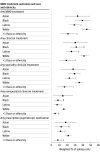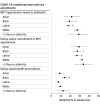Estimates of Major Depressive Disorder and Treatment Among Adolescents by Race and Ethnicity
- PMID: 37812424
- PMCID: PMC10562990
- DOI: 10.1001/jamapediatrics.2023.3996
Estimates of Major Depressive Disorder and Treatment Among Adolescents by Race and Ethnicity
Abstract
Importance: The COVID-19 pandemic has contributed to poorer mental health and a greater need for treatment. Nationally representative estimates of major depressive disorder (MDD) and mental health treatment among US adolescents during the pandemic are needed.
Objective: To estimate MDD prevalence among adolescents, evaluate mental health treatment use among adolescents with MDD, and assess differences by race and ethnicity.
Design, setting, and participants: This cross-sectional analysis of the nationally representative 2021 National Survey on Drug Use and Health included noninstitutionalized US adolescents between the ages of 12 and 17 years (n = 10 743). Analytic weights were applied to all rates and model estimates to be nationally representative and account for sample design and survey nonresponse. Data were collected from January 14 to December 20, 2021, and analyzed from February 11 to April 3, 2023.
Exposures: Self-reported race and ethnicity.
Main outcomes and measures: Dichotomous outcomes of MDD as defined by the Diagnostic and Statistical Manual of Mental Disorders (Fifth Edition), MDD-specific mental health treatment, any type of mental health treatment, telehealth visits, and delays in mental health treatment.
Results: The sample included 10 743 adolescents (51.1% male). Self-reported race and ethnicity included 5.1% Asian, 14.1% Black, 23.3% Latinx, 51.2% White, and 6.3% more than 1 race. Ages were evenly distributed: 34.0% aged 12 to 13 years; 33.3% aged 14 to 15 years; and 32.7% aged 16 to 17 years. Adolescents of more than 1 race or ethnicity had the highest MDD rate (26.5%). Compared with White adolescents, the lowest rates of any MDD treatment overall were found among Latinx adolescents (29.2% [95% CI, 22.2%-36.2%]) and those of more than 1 race or ethnicity (21.1% [95% CI, 11.6%-30.7%]). Similar results were found for treatment by any clinician (Latinx, 25.6% [95% CI, 18.8%-32.4%]; >1 race or ethnicity, 19.1% [95% CI, 9.7%-28.6%]), treatment by a mental health specialist (Latinx, 22.9% [95% CI, 16.9%-28.9%]; >1 race or ethnicity, 16.7% [95% CI, 7.1%-26.3%]), treatment by a nonspecialist clinician (Latinx, 7.3% [95% CI, 3.3%-11.3%]; >1 race or ethnicity, 4.8% [95% CI, 1.9%-7.7%]), and use of any psychotropic medication prescription (Latinx, 11.6% [95% CI, 7.3%-15.9%]; >1 race or ethnicity, 8.3% [95% CI, 2.8%-13.7]). Compared with White adolescents, Black adolescents had lower rates of MDD treatment by any clinician (31.7% [95% CI, 23.7%-39.8%]) and by nonspecialist clinicians (8.4% [95% CI, 3.8%-13.2%]) and experienced lower prescription rates for any psychotropic medication (12.6 [95% CI, 4.6%-20.6%]). Asian (16.0% [95% CI, 5.0%-27.2%]) and Latinx (17.8% [95% CI, 12.6%-23.0%]) adolescents had lower rates of virtual mental health treatment compared with White adolescents. Black (19.1% [95% CI, 14.1%-24.2%]) and Latinx (17.9% [95% CI, 15.0%-21.1%]) adolescents had lower rates of appointments transition to telehealth, while Black adolescents (14.1% [95% CI, 10.7%-17.4%]) experienced delays getting their prescriptions.
Conclusions and relevance: During the first full calendar year of the pandemic, approximately 1 in 5 adolescents had MDD, and less than half of adolescents who needed treatment had any mental health treatment. Adolescents in racial and ethnic minority groups, particularly Latinx, experienced the lowest treatment rates. Federal policy should target adolescents as a whole, and minority populations in particular, to ensure equitable treatment access. Efforts should consider the social, racial, ethnic, and cultural determinants of health.
Conflict of interest statement
Figures




References
-
- Loades ME, Chatburn E, Higson-Sweeney N, et al. . Rapid systematic review: the impact of social isolation and loneliness on the mental health of children and adolescents in the context of COVID-19. J Am Acad Child Adolesc Psychiatry. 2020;59(11):1218-1239.e3. doi:10.1016/j.jaac.2020.05.009 - DOI - PMC - PubMed
-
- Reardon T, Harvey K, Baranowska M, O’Brien D, Smith L, Creswell C. What do parents perceive are the barriers and facilitators to accessing psychological treatment for mental health problems in children and adolescents? a systematic review of qualitative and quantitative studies. Eur Child Adolesc Psychiatry. 2017;26(6):623-647. doi:10.1007/s00787-016-0930-6 - DOI - PMC - PubMed
Publication types
MeSH terms
Grants and funding
LinkOut - more resources
Full Text Sources
Miscellaneous

